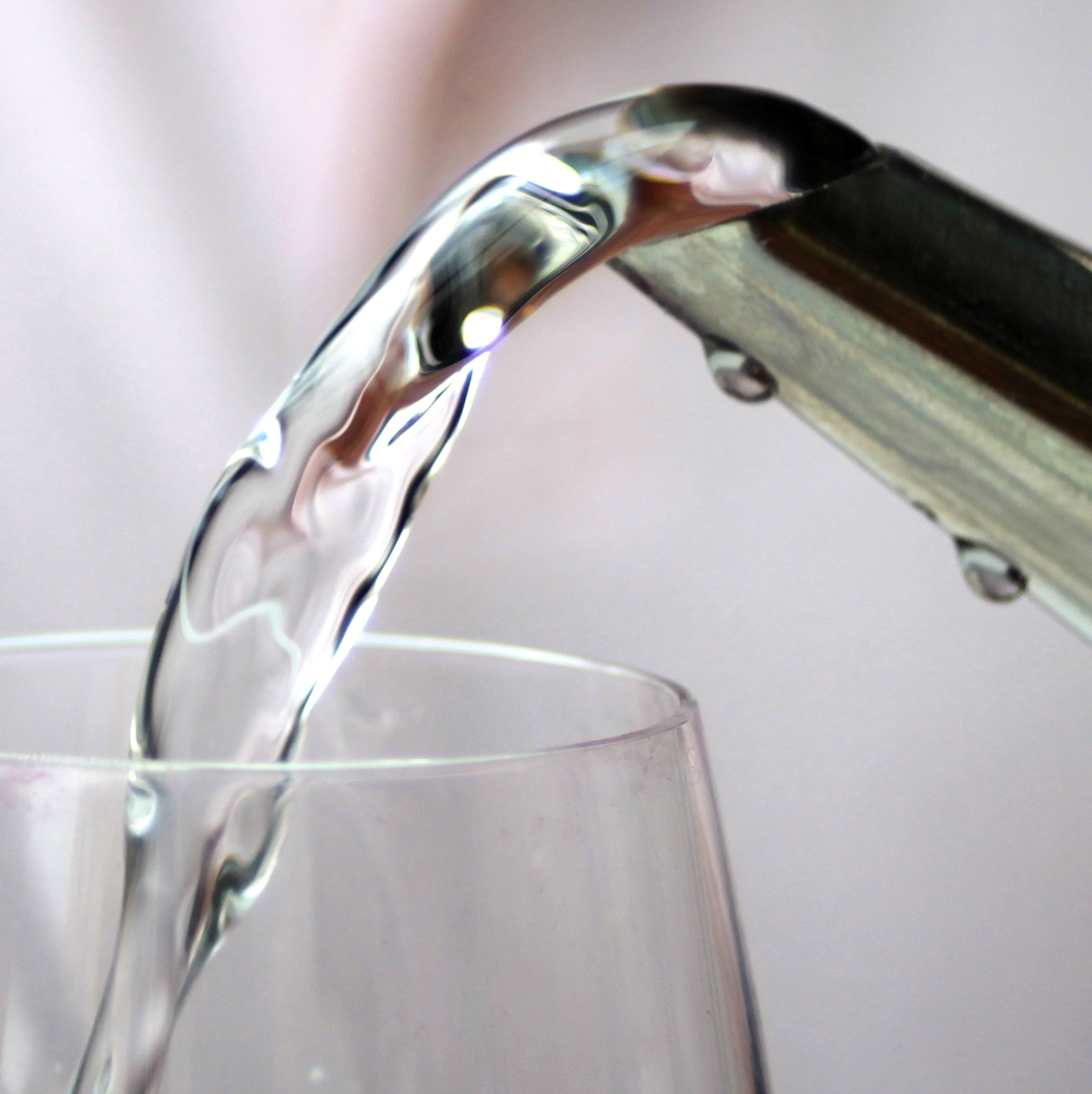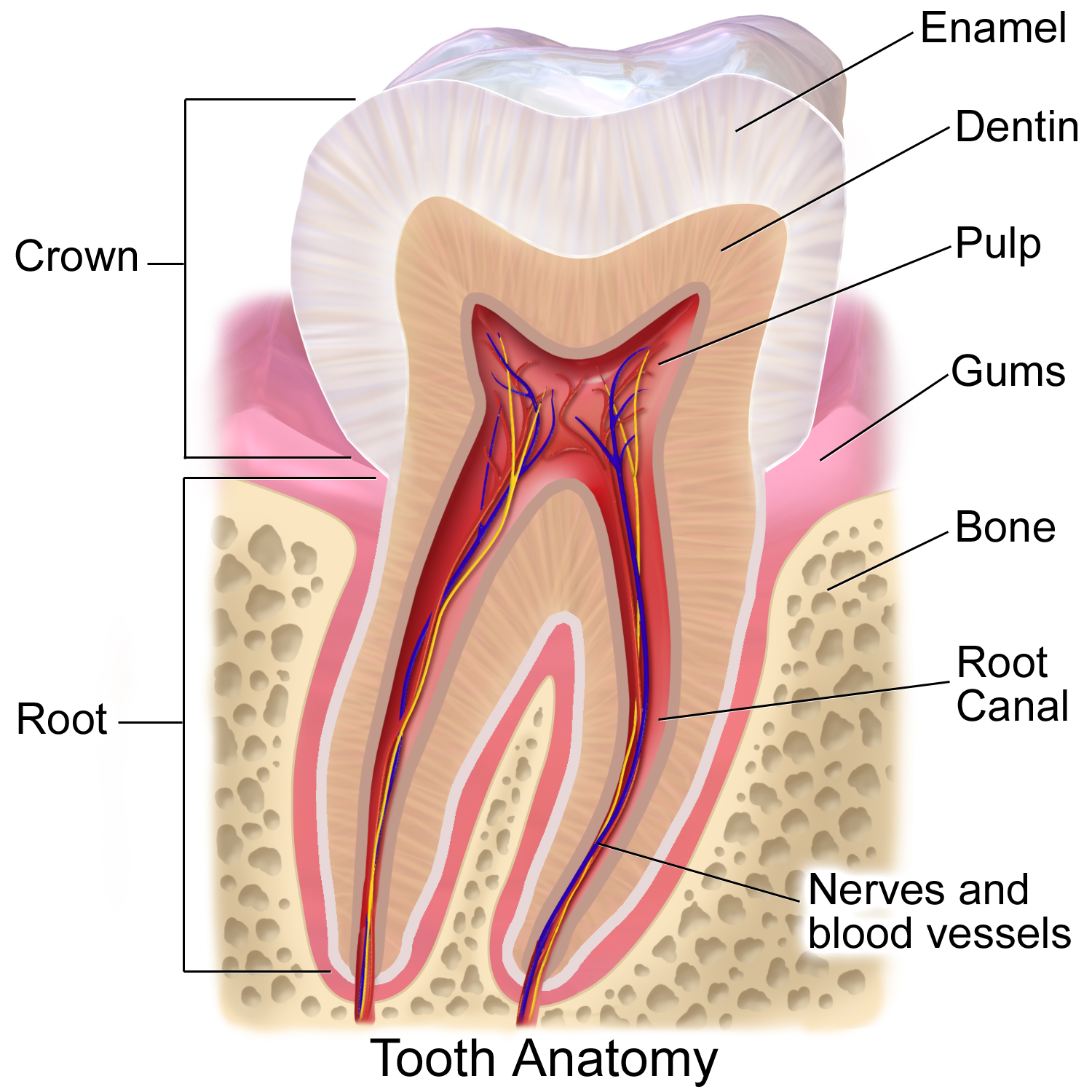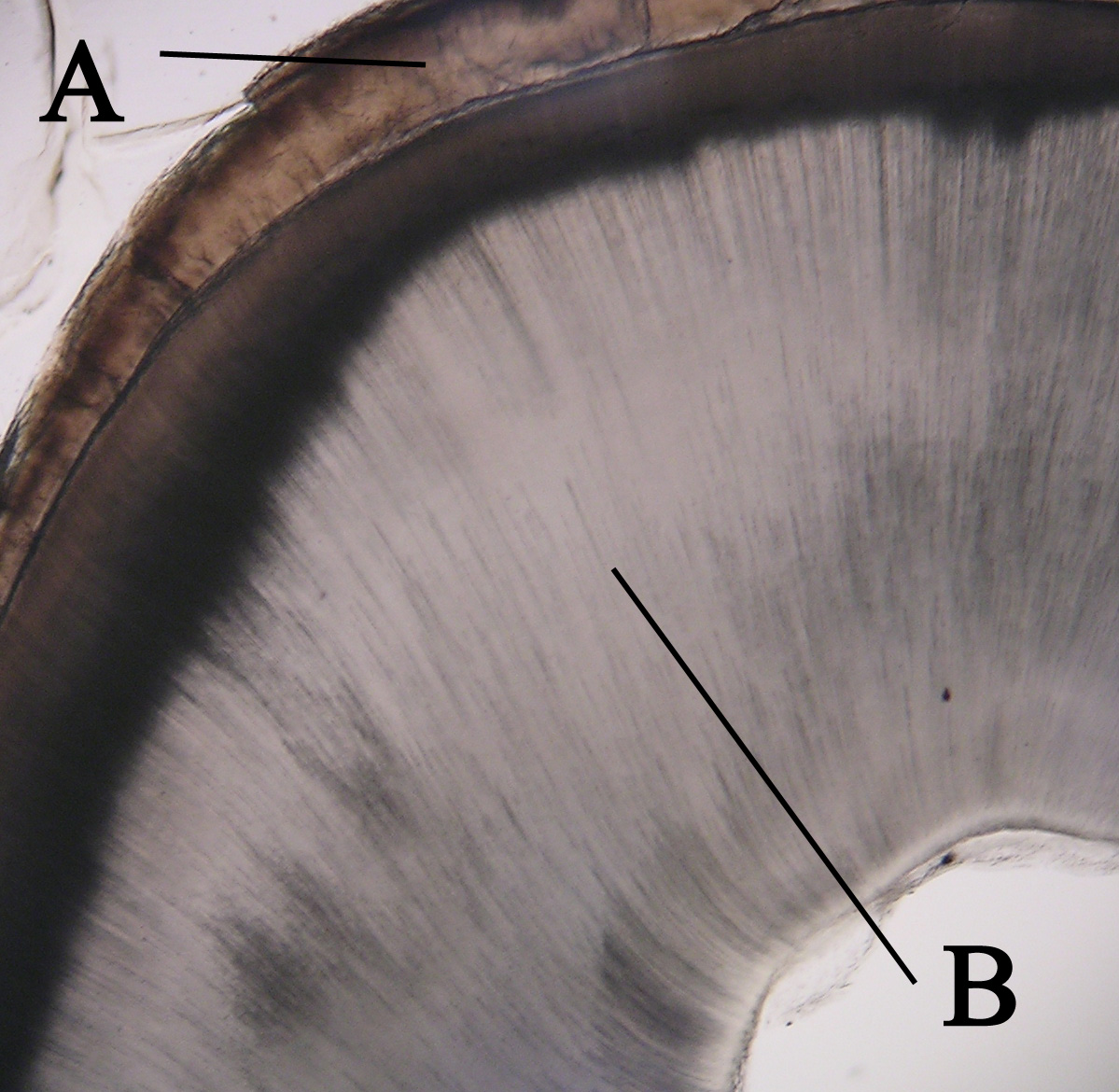|
Caries
Tooth decay, also known as caries,The word 'caries' is a mass noun, and is not a plural of 'carie'.'' is the breakdown of teeth due to acids produced by bacteria. The resulting cavities may be a number of different colors, from yellow to black. Symptoms may include pain and difficulty eating. Complications may include inflammation of the tissue around the tooth, tooth loss and infection or abscess formation. Tooth regeneration is an ongoing stem cell–based field of study that aims to find methods to reverse the effects of decay; current methods are based on easing symptoms. The cause of cavities is acid from bacteria dissolving the hard tissues of the teeth ( enamel, dentin and cementum). The acid is produced by the bacteria when they break down food debris or sugar on the tooth surface. Simple sugars in food are these bacteria's primary energy source and thus a diet high in simple sugar is a risk factor. If mineral breakdown is greater than buildup from sources such as ... [...More Info...] [...Related Items...] OR: [Wikipedia] [Google] [Baidu] |
Water Fluoridation
Water fluoridation is the controlled addition of fluoride to Public water supply, public water supplies to reduce tooth decay. Fluoridated water maintains fluoride levels effective for cavity prevention, achieved naturally or through supplementation. In the mouth, fluoride slows tooth enamel Demineralization (physiology), demineralization and enhances remineralization in early-stage cavities. Defluoridation is necessary when natural fluoride exceeds recommended limits. The World Health Organization (WHO) recommends fluoride levels of 0.5–1.5 mg/L, depending on climate and other factors. In the U.S., the recommended level has been 0.7 mg/L since 2015, lowered from 1.2 mg/L. Bottled water often has unknown fluoride levels. Tooth decay affects 60–90% of schoolchildren worldwide. Fluoridation reduces cavities in children, with Cochrane (organisation), Cochrane reviews estimating reductions of 35% in baby teeth and 26% in permanent teeth when no other fluoride s ... [...More Info...] [...Related Items...] OR: [Wikipedia] [Google] [Baidu] |
Remineralisation Of Teeth
Tooth remineralization is the natural repair process for non-cavitated tooth lesions, in which calcium, phosphate and sometimes fluoride ions are deposited into crystal voids in demineralised enamel. Remineralization can contribute towards restoring strength and function within tooth structure. Demineralization is the removal of minerals (mainly calcium) from any of the hard tissues: enamel, dentine, and cementum. It begins at the surface, and may progress into either cavitation (tooth decay) or erosion (tooth wear). Tooth decay demineralization is caused by acids from bacteria in the dental plaque biofilm whilst tooth wear is caused by acids from non-bacterial sources. These can be extrinsic in source, such as carbonated drinks, or intrinsic acids, usually from stomach acid coming into the mouth. Both types of demineralization will progress if the acid attacks continue unless arrested or reversed by remineralization. Tooth decay process When food or drinks containing fer ... [...More Info...] [...Related Items...] OR: [Wikipedia] [Google] [Baidu] |
Oral Hygiene
Oral hygiene is the practice of keeping one's oral cavity clean and free of disease and other problems (e.g. bad breath) by regular brushing of the teeth (dental hygiene) and adopting good hygiene habits. It is important that oral hygiene be carried out on a regular basis to enable prevention of dental disease and bad breath. The most common types of dental disease are tooth decay (''cavities'', ''dental caries'') and gum diseases, including gingivitis, and periodontitis. General guidelines for adults suggest brushing at least twice a day with a fluoridated toothpaste: brushing before going to sleep at night and after breakfast in the morning. Cleaning between the teeth is called interdental cleaning and is as important as tooth brushing. This is because a toothbrush cannot reach between the teeth and therefore only removes about 50% of plaque from the surface of the teeth. There are many tools available for interdental cleaning which include Dental floss, floss, tape and interden ... [...More Info...] [...Related Items...] OR: [Wikipedia] [Google] [Baidu] |
Tooth Enamel
Tooth enamel is one of the four major Tissue (biology), tissues that make up the tooth in humans and many animals, including some species of fish. It makes up the normally visible part of the tooth, covering the Crown (tooth), crown. The other major tissues are dentin, cementum, and Pulp (tooth), dental pulp. It is a very hard, white to off-white, highly mineralised substance that acts as a barrier to protect the tooth but can become susceptible to degradation, especially by acids from food and drink. In rare circumstances enamel fails to form, leaving the underlying dentin exposed on the surface. Features Enamel is the hardest substance in the human body and contains the highest percentage of minerals (at 96%),Ross ''et al.'', p. 485 with water and organic material composing the rest.Ten Cate's Oral Histology, Nancy, Elsevier, pp. 70–94 The primary mineral is hydroxyapatite, which is a crystalline calcium phosphate. Enamel is formed on the tooth while the tooth develops wit ... [...More Info...] [...Related Items...] OR: [Wikipedia] [Google] [Baidu] |
Fluoride
Fluoride (). According to this source, is a possible pronunciation in British English. is an Inorganic chemistry, inorganic, Monatomic ion, monatomic Ion#Anions and cations, anion of fluorine, with the chemical formula (also written ), whose salts are typically white or colorless. Fluoride salts typically have distinctive bitter tastes, and are odorless. Its salts and minerals are important Reagent, chemical reagents and industrial chemicals, mainly used in the production of hydrogen fluoride for fluorocarbons. Fluoride is classified as a weak base since it only partially associates in solution, but concentrated fluoride is corrosive and can attack the skin. Fluoride is the simplest fluorine anion. In terms of charge and size, the fluoride ion resembles the hydroxide ion. Fluoride ions occur on Earth in several minerals, particularly fluorite, but are present only in trace quantities in bodies of water in nature. Nomenclature Fluorides include compounds that contain ionic ... [...More Info...] [...Related Items...] OR: [Wikipedia] [Google] [Baidu] |
Flossing
Dental floss is a cord of thin filaments, typically made of nylon or silk, used in interdental cleaning to remove food and dental plaque from between teeth or places a toothbrush has difficulty reaching or is unable to reach. Its regular use as part of oral cleaning is intended to maintain oral health. Use of floss is recommended to prevent gingivitis and the build-up of plaque. The American Dental Association claims that up to 80% of plaque can be removed by flossing, and it may confer a particular benefit in individuals with orthodontic devices. However, empirical scientific evidence demonstrating the clinical benefit of flossing as an adjunct to routine tooth brushing alone remains limited. History Levi Spear Parmly (1790-1859), a dentist from New Orleans, is credited with inventing the first form of dental floss. In 1819, he recommended running a waxen silk thread "through the interstices of the teeth, between their necks and the arches of the gum, to dislodge that irr ... [...More Info...] [...Related Items...] OR: [Wikipedia] [Google] [Baidu] |
Dental Flossing
Dental floss is a cord of thin filaments, typically made of nylon or silk, used in interdental cleaning to remove food and dental plaque from between teeth or places a toothbrush has difficulty reaching or is unable to reach. Its regular use as part of oral cleaning is intended to maintain oral health. Use of floss is recommended to prevent gingivitis and the build-up of plaque. The American Dental Association claims that up to 80% of plaque can be removed by flossing, and it may confer a particular benefit in individuals with orthodontic devices. However, empirical scientific evidence demonstrating the clinical benefit of flossing as an adjunct to routine tooth brushing alone remains limited. History Levi Spear Parmly (1790-1859), a dentist from New Orleans, is credited with inventing the first form of dental floss. In 1819, he recommended running a waxen silk thread "through the interstices of the teeth, between their necks and the arches of the gum, to dislodge that irritatin ... [...More Info...] [...Related Items...] OR: [Wikipedia] [Google] [Baidu] |
Dentistry
Dentistry, also known as dental medicine and oral medicine, is the branch of medicine focused on the Human tooth, teeth, gums, and Human mouth, mouth. It consists of the study, diagnosis, prevention, management, and treatment of diseases, disorders, and conditions of the mouth, most commonly focused on dentition (the development and arrangement of teeth) as well as the oral mucosa. Dentistry may also encompass other aspects of the craniofacial complex including the temporomandibular joint. The practitioner is called a dentist. The history of dentistry is almost as ancient as the history of humanity and civilization, with the earliest evidence dating from 7000 BC to 5500 BC. Dentistry is thought to have been the first specialization in medicine which has gone on to develop its own accredited degree with its own specializations. Dentistry is often also understood to subsume the now largely defunct medical specialty of stomatology (the study of the mouth and its disorders and dis ... [...More Info...] [...Related Items...] OR: [Wikipedia] [Google] [Baidu] |
Brushing One's Teeth
Tooth brushing is the act of scrubbing teeth with a toothbrush equipped with toothpaste. Interdental cleaning (with floss or an interdental brush) can be useful with tooth brushing, and together these two activities are the primary means of cleaning teeth, one of the main aspects of oral hygiene. The recommended amount of time for tooth brushing is two minutes each time for two times a day. History Teeth-cleaning twigs have long been used throughout human history. As long ago as 3000 B.C., the ancient Egyptians constructed crude toothbrushes from twigs and leaves to clean their teeth. Similarly, other cultures such as the Greeks, Romans, Arabs and Indians also cleaned their teeth with twigs. Some would fray one end of the twig so that it could penetrate between the teeth more effectively. In the Islamic prophetic tradition, Muhammad taught his disciples to brush their teeth using miswak five times per day, and this remains prevalent amongst many Muslims world wide since ... [...More Info...] [...Related Items...] OR: [Wikipedia] [Google] [Baidu] |
Teeth
A tooth (: teeth) is a hard, calcified structure found in the jaws (or mouths) of many vertebrates and used to break down food. Some animals, particularly carnivores and omnivores, also use teeth to help with capturing or wounding prey, tearing food, for defensive purposes, to intimidate other animals often including their own, or to carry prey or their young. The roots of teeth are covered by gums. Teeth are not made of bone, but rather of multiple tissues of varying density and hardness that originate from the outermost embryonic germ layer, the ectoderm. The general structure of teeth is similar across the vertebrates, although there is considerable variation in their form and position. The teeth of mammals have deep roots, and this pattern is also found in some fish, and in crocodilians. In most teleost fish, however, the teeth are attached to the outer surface of the bone, while in lizards they are attached to the inner surface of the jaw by one side. In cartilaginous ... [...More Info...] [...Related Items...] OR: [Wikipedia] [Google] [Baidu] |
Dentin
Dentin ( ) (American English) or dentine ( or ) (British English) () is a calcified tissue (biology), tissue of the body and, along with tooth enamel, enamel, cementum, and pulp (tooth), pulp, is one of the four major components of teeth. It is usually covered by enamel on the crown and cementum on the root and surrounds the entire pulp. By volume, 45% of dentin consists of the mineral hydroxyapatite, 33% is organic material, and 22% is water. Yellow in appearance, it greatly affects the color of a tooth due to the translucency of enamel. Dentin, which is less mineralized and less brittle than enamel, is necessary for the support of enamel. Dentin rates approximately 3 on the Mohs scale of mineral hardness. There are two main characteristics which distinguish dentin from enamel: firstly, dentin forms throughout life; secondly, dentin is sensitive and can become hypersensitive to changes in temperature due to the sensory function of odontoblasts, especially when enamel recedes an ... [...More Info...] [...Related Items...] OR: [Wikipedia] [Google] [Baidu] |
Tooth Loss
Tooth loss is a process in which one or more teeth come loose and fall out. Tooth loss is normal for deciduous teeth, deciduous teeth (baby teeth), when they are replaced by a person's permanent teeth, adult teeth. Otherwise, losing teeth is undesirable and is the result of injury or disease, such as dental avulsion, tooth decay, and gum disease. The condition of being toothless or missing one or more teeth is called ''edentulism''. Tooth loss has been shown to causally reduce overall health and wellbeing as it increases the probability of depression. Tooth exfoliation in children Normal loss of Deciduous teeth, primary teeth typically begins around age six and continues until age twelve. The upper and lower central Incisor, incisors are shed at age six to seven years. The upper and lower lateral incisors are shed at seven to eight years. The upper Canine tooth, canines are shed at ten to twelve years. The lower canines are shed at nine to twelve years. The upper and low ... [...More Info...] [...Related Items...] OR: [Wikipedia] [Google] [Baidu] |








